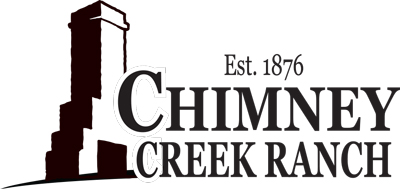Smith's Station: Unearthing a Texas stage stop when East finally met the West
Greg Jaklewicz, Editor/News Director
Abilene Reporter-News
It was around for only 30 months, but it's part of Texas history.
Between 1858-61, stagecoaches rumbled along Butterfield Overland Mail Route, from St. Louis, Mo., to San Francisco, Calif. It was the first transcontinental mail service, a semi-weekly service that was federally funded.
It crossed what today are six states — Missouri, Tennessee, Arkansas, Texas, New Mexico, Arizona and California.
It also was a passenger service, for those hardy enough to weather a rugged journey. Each person could carry only 40 pounds in luggage.
"Safe and sound .., in 23 days, 23 hours and a half, just one day and half an hour less than the time required, "wrote Waterman L. Ormby, a 23-year-old journalist who was the first passenger in 1858, upon completion of his journey. Company founder John W. Butterfield Sr. also rode along, but only to Fort Smith, Ark.,
The total trek covered 2,800 miles and took 25 days, even operating around the clock.
The cost? Just $200 to go West, $100 to go back East. Passengers paid from 40 cents to $1 for a meal — eating whatever was prepared.
It was regarded as fast as blazes, even if the average speed was slow as molasses at times: 5 mph.
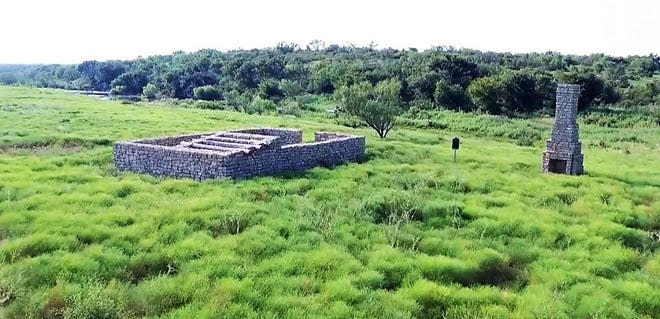
Mail previously had to go by ship around the stormy tip of South America or through Panama. That took months.
This was way before Amazon delivered to your doorstep.
Miles and miles of Texas
Much of the overland journey was through Texas.
There were about 200 stops on the journey, with 50 in Texas alone. The service operated on a fairly strict time schedule, something new back then.
The line was created by John W. Butterfield Sr., who would form American Express with Henry Wells and William Fargo, who also had their own firm. Butterfield, however, was better equipped for the long overland mail route.
For a westbound trip, stages crossed the Red River near Dennison in north Texas and exited the state at El Paso. The route actually split in West Texas, near McCamey, before the two paths — one going through the Big Bend region and the other more to the north through the Guadalupe Pass — joined in El Paso.
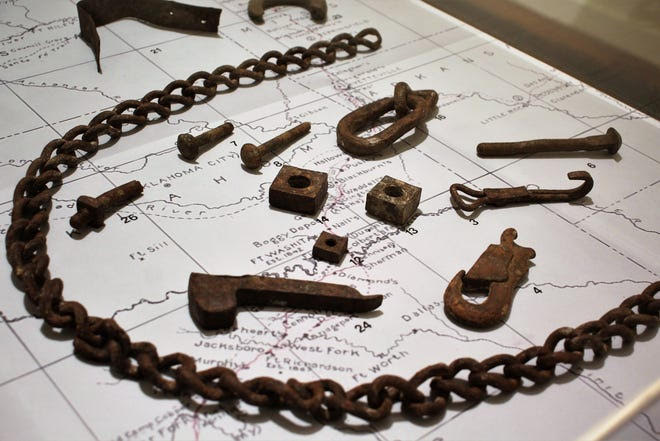
The south route was preferred because of water availability and less fear of attacks by Comanches.
It trekked south of present-day Wichita Falls, following a route that included West Texas forts such as Phantom Hill north of Abilene and Chadbourne north of San Angelo. It then went west.
Stops nearest Abilene, which had yet to founded, were Clear Fork, Smith's Station, Fort Phantom Hill, Mountain Pass, Valley Creek and Fort Chadbourne.
The route through Shackelford County is believed to be based on a military track from forts Griffin and Phantom Hill. Smith's Station was located near Chimney Creek, a tributary of the Clear Fork of the Brazos River. It was about 30 miles north of what today in Abilene and 15 miles west of today's Albany.
The stop offered a bit of rest and a change of teams. About 1,800 horses and mules were used to cover the long distance, as well as 250 coaches.
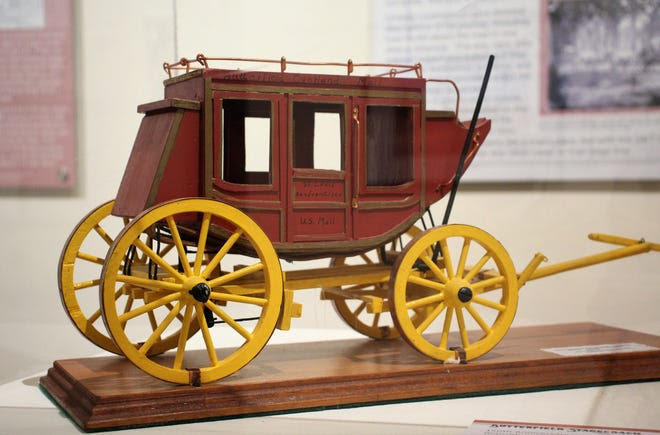
While service ended in 1861, the Smith's Station area in Shackelford was not done. Cattle drivers Charles Goodnight and Oliver Loving three times drove herds through the area, beginning in 1866.
Stagecoach passengers had seen the deer and the antelope play, and lots of turkeys.
Chimney Creek became a ranch in 1876. Today, it's owned by brothers Hank and Ted Paup and home to four historical markers. Chimney Creek has been recognized as a "Texas Century Family Ranch" — property that has been in one family for at least 100 years — and a Lone Star Land Stewardship Award, given by Texas Parks and Wildlife.
This century, researchers have come to the site and unearthed mostly small items — shell casings, nails, buttons, handles, chest hinges and more.
At the site, a replica chimney has been erected and its open-air corral recreated.
"No house had been built yet," Ormsby wrote. "Those at the station living in tents. They had nearly finished a fine corral for stock, making it of brush (as no timber could be had) and filling in the chinks with mud.
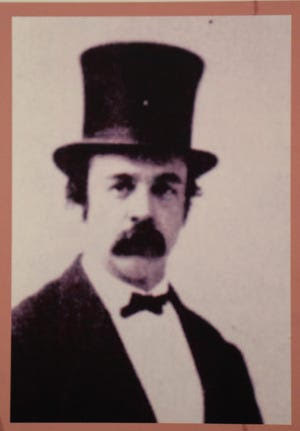
"Our supper consisted of cake cooked in the coals, clear coffee and some dried beef cooked by Mrs. Smith's best style. We changed horses or mules and swallowed supper in double quick time and were soon on our way again."
The history of this particular site — named for the couple that ran it — and the trail as a whole comprises a new historical exhibit at The Grace Museum.
It opened Dec. 1 and continues through July 15. Four lectures are planned, including one May 18 by Michael Grauer, formerly of Panhandle Plains Historical Museum in Canyon and now at the National Cowboy & Western Heritage Museum in Oklahoma City.
All in the same family
The ranch was established in 1876 by brothers George B. and John F. Horsful.
In 1920, the Paups' great grandfather, George Robert Davis, purchased Chimney Creek in 1920. For $4 an acre.
The Davises would move to the growing city of Abilene in 1923, with famed local architect David S. Castle building their home on Victoria Street.
Davis' wife, Robbie Davis Johnson, inherited the ranch in 1956 and ran it until 1973.

The boys' mother, Mary Frances Johnson Paup Driscoll — also known as "Chan" — inherited the ranch. She died in 2007, and her boys took over operation.
A guesthouse was built about 40 years ago so people could stay at the ranch.
"Ann (his wife) and I probably make 15-18 trips out there a year," Hank Paup said at the opening night event. That's about 600 trips to the ranch since 1981.
They knew about Smith's Station but had been told "nothing's there" anymore, Hank Paup said. There were some stone pieces in the ground but little else. The story is other stones were crushed to build the base for a nearby state highway.
When George R. Davis' granddaughter, Driscoll, wrote an essay titled "Chimney Creek Crossings," the history ball began rolling.
The history
In 1982, a historical marker was placed there.
Hank Paup joked that started a pattern of notable events every 10 years.
In 1992, he said, it was determined that if the ranch were to be called Chimney Creek, "we needed a chimney," he said. It was a smaller version of those that remain today 25 miles away at Fort Phantom Hill.
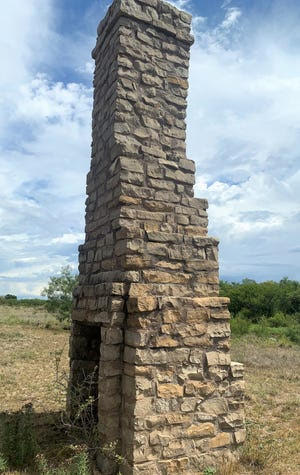
It's so realistic that a historical video later made identified it as standing since 1858.
"The craziest thing that happened was 10 years after that," he said.
That is when "three men approached us to do a historical survey of Smith Station," Paup said. "One of them was a guy named Joe Allen."
That is not the same Joe Allen who operated a barbecue restaurant for years in Abilene. This Joe Allen is a graduate of Hardin-Simmons University in Abilene who spent 31 in school administration before returning to his love — archaeology.
"He is not educated to be a Ph.D. in archaeology but he is a Ph.D. in archaeology," Paup said. The trio arrived on Saturday. "We told them there wasn't anything there and they were wasting their time."
But if they found anything, it stays with the ranch.
They met up again that night at the Beehive, a popular restaurant in Albany.
Did y'all find anything?
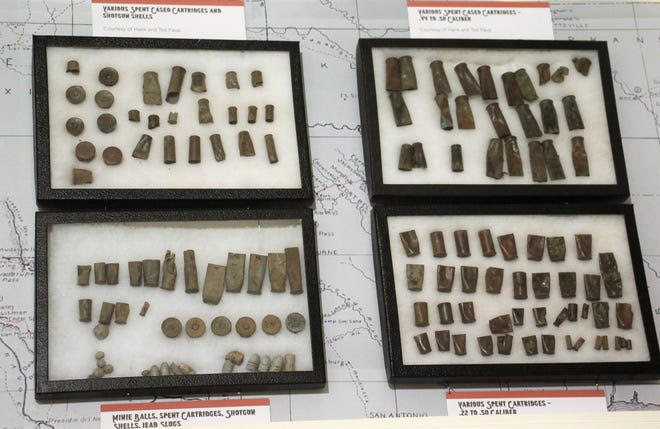
Yessir, we did.
"They pulled up in a pickup with 200 metal objects they had pulled out the ground," Paup said. "All buried six inches underneath the ground.
"He is what I call the king of the metal detector."
More to come
The family than asked Allen to do a further study at Chimney Creek and specifically for Smith Station.
To date, more than 2,000 artifacts have been discovered.
"And 10 years after that, we said, 'Well, let's build Smith's Station,'" Paup said. They looked at other stations and copied the one at Delaware Springs in what today is Culberson County, east of El Paso.
It was about 26 feet by 40 feet, with a 12 foot-by-12-foot enclosure.
"And 10 years from that, now, we're at The Grace Museum," he said. "I don't know what it's going to be like 10 years from now."
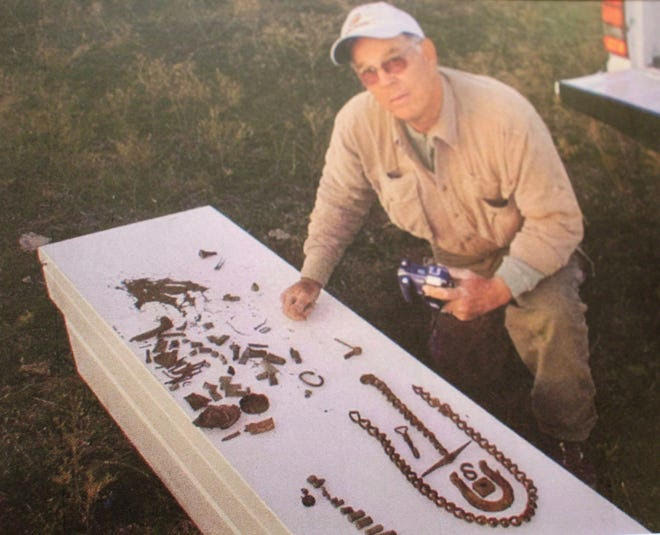
Allen was called on to speak Dec. 1 in the Grace ballroom.
"I wasn't expecting to say anything tonight," he said at the opening. "I'm a lot better at digging holes."
Allen called the Paups "wonderful stewards" of the land.
"Those of us who understand history, archaeology, culture and all that know how important being good stewards of the ground is," he said.
Allen said he was just tagging along that day with Patrick Dearden and a guy writing a book, Glen Ely ("The Texas Frontier and the History of the Butterfield Overland Mail, 1858-61"). A researcher, Ely would ask permission from land owners to "do what he wanted to and that was visit the site," Allen said. "And I was the grunt.
"I am not a professional archaeologist, but I have 75 years experience in the field. Hank said there's nothing out there and I said, 'Hank if you have a Butterfield Overland stop, there's something out there," Allen said.
"We found lots of things. Nothing of extreme value."
Well, except for the hard-forged fish hook. Allen put a value of $350 on it.
Hank Paup, he said, asked how he came up with that right off the top of head
"Because," Allen said, "that's what I'd give you for it."
A place of history
There is more to see than just where the stagecoach station once was located.
Dr. Monte Monroe, Texas State Historian and archivist of the Southwest Collection at Texas Tech, said at the Dec. 1 opening that there is more to the history of the site than just the station, and even the cattle drive routes. For example, located on the property during the Cold War was a communications pit with hardline cables that connected a dozen Atlas missiles silos controlled from Dyess Air Force Base in nearby Abilene.
"We were ground zero back in the day, he said.
Opening night attendees were encouraged to go to chimneycreekranch.com to learn more about the ranch and see images of it.
"Today," Monroe said, "the historic ruins are protected and well interpreted on Chimney Creek Ranch.
If You Go
What: "Smith's Station on the Butterfield"
When: Through July 15
Where: The Grace Museum, 102 Cypress St., Abilene
Hours: Open 10 a.m-5 p.m. Tuesdays-Saturdays, and 5-8 p.m. Thursdays (no admission charge). Closed Dec. 23-31 for Christmas, and Jan. 1 for New Year's Day.
Admission: $6 adults; $3 for youths 4-17 and adults age 65+; free for active-duty military and youths 3 and under.
